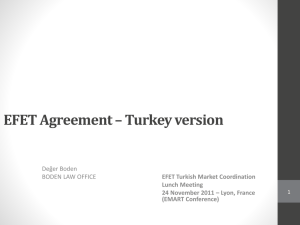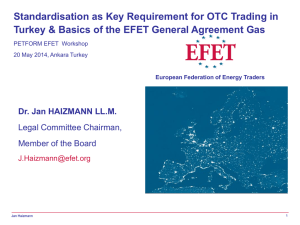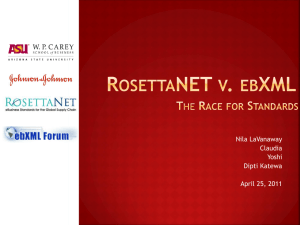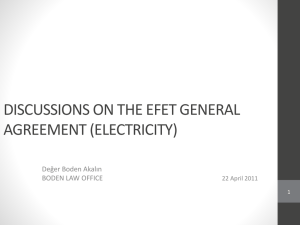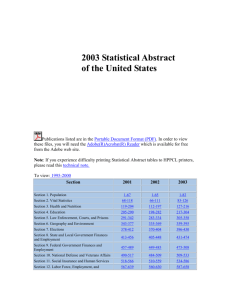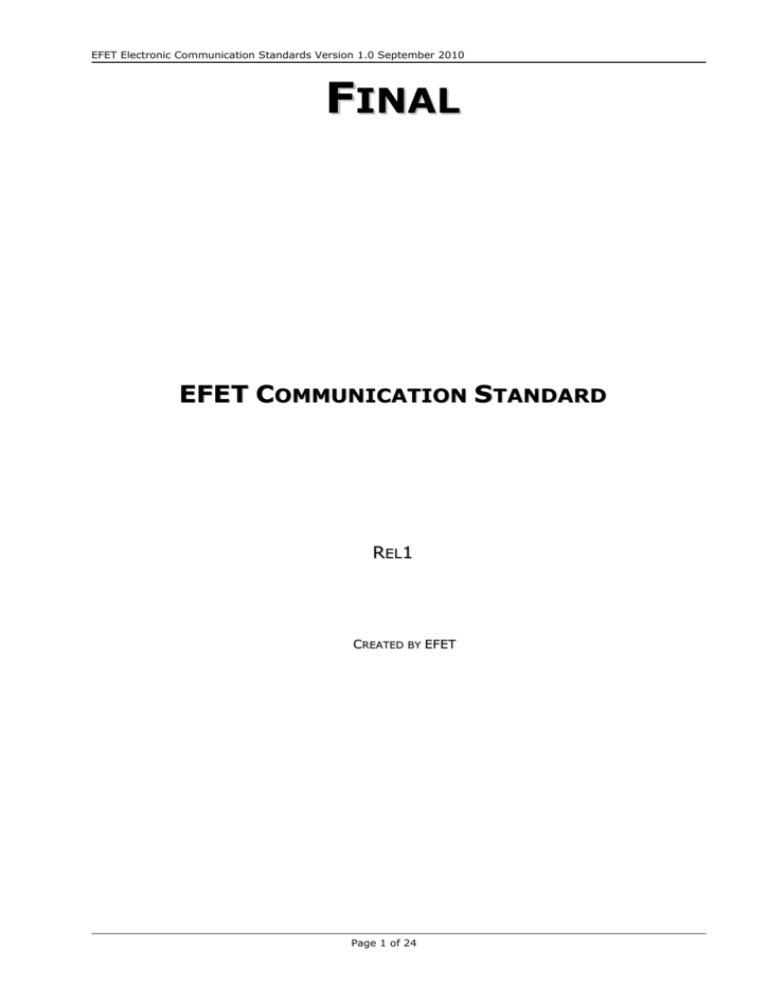
EFET Electronic Communication Standards Version 1.0 September 2010
FINAL
EFET COMMUNICATION STANDARD
REL1
CREATED BY EFET
Page 1 of 24
EFET Electronic Communication Standards Version 1.0 September 2010
Revision History
Version
Date
Changes
Author of changes
0.1a
Sep 2009
Initial version for discussion within
the EFET IT Architecture WG.
EFET IT Architecture
Work Group
0.2a
Dec 2009
Updated following feedback from the
EFET IT Architecture WG.
EFET IT Architecture
Work Group
0.3a
Feb 2010
Updated following feedback from the
EFET IT Architecture WG.
EFET IT Architecture
Work Group
0.3b
Feb 2010
Updated following internal review.
EFET IT Architecture
Work Group
0.3c
Apr 2010
Updated following feedback from the
EFET IT Architecture WG, issued to
software providers.
EFET IT Architecture
Work Group
0.4a
June 2010
Updated to incorporate feedback
from implementers and changes to
support Hub processing
EFET IT Architecture
Work Group
1.0
September
2010
Final version
EFET IT Architecture
Work Group
Page 2 of 24
EFET Electronic Communication Standards Version 1.0 September 2010
Copyright notice
Copyright © EFET 2010. All Rights Reserved.
This document and translations of it may be copied and furnished to others, and derivative works that
comment on or otherwise explain it or assist in its implementation may be prepared, copied, published
and distributed, in whole or in part, without restriction of any kind, provided that the above copyright
notice and this paragraph are included on all such copies and derivative works. However, this
document itself may not be modified in any way, such as by removing the copyright notice or
references to EFET except as required to translate it into languages other than English.
The limited permissions granted above are perpetual and will not be revoked by EFET or its
successors.
This document and the information contained herein is provided on an "as is" basis.
EFET DISCLAIMS ALL WARRANTIES, EXPRESS OR IMPLIED, INCLUDING BUT NOT LIMITED TO ANY
WARRANTY THAT THE USE OF THE INFORMATION HEREIN WILL NOT INFRINGE ANY RIGHTS OR ANY
IMPLIED WARRANTIES OF MERCHANTABILITY OR FITNESS FOR A PARTICULAR PURPOSE.
Page 3 of 24
EFET Electronic Communication Standards Version 1.0 September 2010
Content
1
EXECUTIVE SUMMARY....................................................................................................................... 5
1.1
The Need for EFET Standards ....................................................................... 5
Problem Definition.................................................................................................... 5
The Solution: EFET Standards.................................................................................... 5
1.2
2
3
Conclusions ............................................................................................... 6
OVERVIEW ........................................................................................................................................ 7
2.1
Roles and Responsibilities in Standardisation ................................................. 7
2.2
Version Control .......................................................................................... 7
EFET COMMUNICATION PROTOCOL AND INTERFACES..................................................................... 8
3.1
Business Requirements ............................................................................... 8
3.2
EFET Communication Model ......................................................................... 8
3.3
Security and Reliability Requirements ........................................................... 8
3.4
Existing Standards Used .............................................................................. 9
3.5
EFET Communication Protocol Profile ............................................................ 9
Motivation ............................................................................................................... 9
Definition of Terms................................................................................................... 9
Specification............................................................................................................ 9
ebXML Services ...................................................................................................... 11
Communication Partner Agreements.......................................................................... 11
Message Security .................................................................................................... 11
Message Exchange .................................................................................................. 12
Transport Protocols ................................................................................................. 12
Transport-Specific Items .......................................................................................... 13
HTTPS ................................................................................................................... 13
HTTP ..................................................................................................................... 14
SMTP..................................................................................................................... 14
SOAP..................................................................................................................... 15
SOAP Envelope ....................................................................................................... 15
SOAP Header.......................................................................................................... 15
SOAP Body ............................................................................................................. 17
Payload ................................................................................................................. 18
3.6
Example for an HTTP EFET ebXML Message .................................................. 19
3.7
EFET Communication Business Process Profile Template ................................ 22
3.8
Out-Of-Scope Topics ................................................................................. 22
Agreement Management .......................................................................................... 23
Public Key Infrastructure and Certificate Management ................................................. 23
APPENDIX A.
NORMATIVE REFERENCES ......................................................................................... 24
List of Figures
Figure 1 Structure of the EFET Standards .................................................................................... 6
Figure 2 Organisation of EFET Work Groups and Responsibilities for Standards Documentation .......... 7
Figure 3 ebXML Message Service .............................................................................................. 10
Figure 4 ebXML Message Structure ........................................................................................... 10
Page 4 of 24
EFET Electronic Communication Standards Version 1.0 September 2010
1
Executive Summary
1.1 The Need for EFET Standards
Problem Definition
Communication is an essential key to the successful integration of business processes.
Successful communication requires that the communicating parties speak the same language. This
fact is as important in electronic communication as it is in face to face communication.
As volumes increase in energy trading, business transactions are occurring more rapidly, and trading
volumes are growing, traditional means of communication like phone and fax are necessarily being
replaced as a core communication medium by automated electronic communication.
Increasingly energy trading companies are looking towards the integration of internal and external
business processes, with the eventual aim of straight-through processing. This is to enhance process
efficiency, as well as to reduce operational risk, both of which reduce overall transaction costs.
The energy trading industry does not have in use widely accepted electronic communication
standards. Like the financial industry there are some standards for specific parts of the industry, but
the fragmentation is arguably even higher in the energy trading industry. Currently each service
provider (exchanges, broker platforms, clearing houses, matching services, etc.) and each software
vendor use their own proprietary “standard”, requiring implementation of a different interface and
cumbersome translation for each of these “standards”. This results in a costly and risky “spaghetti”
network of interfaces.
To solve the business process integration problem, common electronic communication
standards (a common language) must be established and adopted across the energy
industry. The messages and processes that need standardisation in the energy trading industry
include Trade Confirmations, Scheduling and Logistics, Clearing and Settlement, and Quotes.
By standardising the exchange of this information and the corresponding processes both internally and
externally, companies can reduce costs and streamline business processes. Standardisation must be
driven by the industry itself, and coordinated and governed by an accepted industry wide neutral
body.
The Solution: EFET Standards
The European Federation of Energy Traders (EFET) is an independent industry wide body that can
coordinate the creation and maintenance of industry standards. Under EFET governance, project work
groups comprising members from the industry have been convened that are specifically responsible
for defining the EFET Communication Standard.
EFET’s approach is to define a dedicated standard for each business process and a single common
communication standard to provide a common foundation for electronic data exchange required by
each business processes. This structure is visualised in Figure 1 Structure of the EFET Standards.
Page 5 of 24
EFET Electronic Communication Standards Version 1.0 September 2010
Figure 1 Structure of the EFET Standards
There are currently four business process standards defining the structure of electronic messages and
how these electronic messages are exchanged. The EFET Communication Standard defines the
technical communication protocol for electronic messages exchanged in the energy trading
environment, and therefore can be considered a general standard.
1.2 Conclusions
Communication is an essential key to the successful integration of business processes. To solve the
business process integration problem, common electronic communication standards (a common
language) must be established and adopted across the energy industry.
Benefits of the EFET Communication Standard include the reduction of technical barriers to
communication within the European energy market between all market players including traders,
brokers, transmission system operators and financial service providers such as clearing houses and
clearing banks. A common, widely adopted open communication standard also supports competition
through removal of barriers to market entry for new service providers as well as facilitating both peerto-peer communication and central service provision.
It is expected that further standardisation work will be done to facilitate the electronic exchange of
data to further increase efficiency in the European Energy Industry. This is out of the scope of this
document.
Page 6 of 24
EFET Electronic Communication Standards Version 1.0 September 2010
2
Overview
2.1 Roles and Responsibilities in Standardisation
The EFET Board oversee all the activities undertaken or sponsored by EFET. Responsibility for
coordination of Back Office activities has been delegated to the Back Office (BO) Group. Responsibility
for coordination of IT activities has been delegated to the IT Architecture (ITA) Work Group. Other
project work groups exist to focus on and develop standards for specific processes, e.g. confirmation
matching. Each business standard is sponsored by the EFET Board, controlled by the BO Group and
comprises specialist personnel from business and IT functions. The communication standard is the
responsibility of the ITA Work Group.
2.2 Version Control
EFET standards documentation comprises a single document with chapters and sections.
1) The single document shall be a release item under control of the relevant EFET work group on
behalf of the EFET Board with major versioning e.g. 1.0, 2.0, 3.0.
2) Each chapter shall be a configuration item within the single document controlled by either the
IT Architecture Work Group and audited via the Revision History between major releases
leading to intermediate versioning e.g. 1.1, 1.2, 1.3. (Also release version with change bars)
Note that draft versions are signified by using a letter: e.g. 1.1a.
Figure 2 Organisation of EFET Work Groups and Responsibilities for
Standards Documentation
Page 7 of 24
EFET Electronic Communication Standards Version 1.0 September 2010
EFET Communication Protocol and Interfaces
3
This chapter presents the communication protocol used to transport all EFET standard business
process messages. The communication protocol can be extended to other messages as require.
3.1 Business Requirements
The communication standard defined here seeks to support the business requirement for flexibility
within the standard. As well as allowing for diversity in B2B communication between different
organisations, this requirement also relates to broader application of the standard to support other
processes, message sets and potentially communication with (and within) other segments of the
energy market. It is accepted that such flexibility in the standard means more complexity in
implementation of EFET business processes, however this consideration is outweighed by the
requirement for the standard to provide a solid foundation for broad based B2B interoperation, as well
as to support diversity in B2B communication for EFET business processes and beyond.
3.2 EFET Communication Model
The EFET communication model is designed to be simple to implement, but flexible enough to enable
new business processes to be added as required. The model can be summarised as a message
originator sends a message containing a payload to a message recipient.
The standard does not mandate or assume anything about
processes which create or consume the payload
the format of the payload
the security of the payload
This is defined at a process specific level, see sub-section Payload in section 3.5.
By taking a payload agnostic approach, new processes can be easily added, including support for nonEFET processes (e.g. EASEEgas). The model also enables the use of a service partner to route
messages on behalf of end user organisations.
Each business process enables users to define where messages will originate from and be sent to.
Note that it is not mandated that this is the same end point for all processes. The implementation of
process end points is out of scope for this document.
3.3 Security and Reliability Requirements
Most Internet protocols only support channel encryption/authentication (as in the case of HTTPS), not
end-to-end document encryption/authentication from application to application. To secure the path
from application to application via the internet, DMZs and firewalls of the communicating
organisations, the EFET Communication Protocol must meet the following security requirements:
Authentication (verification of identity)
Confidentiality (document encryption)
Data Integrity (document signing)
Non-repudiation (proof of document receipt)
Authentication ensures that message originators are whom they purport to be.
Confidentiality ensures that messages can be read only by authorised entities.
Data integrity ensures that messages are unchanged from their source and have not been
accidentally or maliciously altered.
Non-repudiation ensures that strong and substantial evidence is available that a message has been
sent or received.
Page 8 of 24
EFET Electronic Communication Standards Version 1.0 September 2010
Furthermore in order for these security measures to take full effect the EFET Communication Protocol
must implement reliable messaging over unreliable underlying transport mechanisms, i.e. it must
guarantee that
an originator knows if a message has been delivered or not,
a message is received at most once by a recipient.
3.4 Existing Standards Used
All external reference documents are listed in Appendix A.
The EFET Communication Standard is based on the ebXML Message Service Protocol defined in the
ebXML Message Service Specification Version 2.0 (Appendix A.[1]).
ebXML Messaging is in use as an existing standard and is already widely accepted by different
industries and provides the required security related functions.
3.5 EFET Communication Protocol Profile
Motivation
The ebXML Message Service Specification defines a generic protocol for exchanging electronic business
documents that is designed to work for many different scenarios and use cases. This is achieved by
introducing a number of options for business applications implementing this specification.
Hence each electronic business process based on ebXML Messaging must make a number of choices
about the exact use of the ebXML Message Service Protocol in order to achieve compatibility and
interoperability between different business applications implementing this process.
The EFET Communication Standard defines and fixes a certain subset of these choices to be shared by
all electronic business process specifications based on it. The definition of the remaining choices is
passed on to each individual electronic business process specification.
Definition of Terms
An “EFET Communication Protocol Profile” specifies a choice for every optional item or degree of
freedom given in the ebXML Message Service Specification Version 2.0.
Every EFET Communication Protocol Profile is split into two parts, one process-specific part called an
“EFET Communication Business Process Profile” and one fixed and shared part called “EFET ebXML
Messaging Standard Profile”.
For one particular electronic business process the associated EFET Communication Business Process
Profile is named “EFET Communication [Business Process Name] Profile” where the bracket expression
is replaced with the name of this electronic business process.
Each electronic business process specification based on the EFET Communication Standard must
contain exactly one such profile.
The EFET Communication Standard defines the EFET ebXML Messaging Standard Profile and the list of
items to be considered in each EFET Communication Business Process Profile.
Specification
The EFET Communication Protocol Profile is structured alongside the two central architectural
elements of the ebXML Message Service Specification, the ebXML Message Service Handler (see
Appendix A.[1], 1.2.4) and the ebXML Message Structure (see Appendix A.[1], 2.1).
Page 9 of 24
EFET Electronic Communication Standards Version 1.0 September 2010
Figure 3 ebXML Message Service
Figure 4 ebXML Message Structure
Page 10 of 24
EFET Electronic Communication Standards Version 1.0 September 2010
ebXML Services
MESSAGESERVICE
This section refers to Appendix A.[1], 1.2.4 and is part of the EFET ebXML Messaging Standard Profile.
Every business application conforming to the EFET Communication Standard and implementing an
electronic business process specification based on this standard must utilise a compliant ebXML
Message Service implementation configured (or customised) with all settings contained in the EFET
Communication Protocol Profile associated to this electronic business process.
PING SERVICE
This section refers to Appendix A.[1], 8 and is part of the EFET ebXML Messaging Standard Profile.
The Message Service Handler Ping Service must be available.
Communication Partner Agreements
The ebXML Message Service Specification requires an agreement to exist between communication
partners (see Appendix A.[1], 1.2.2, lines 340 – 360) and it uses a Collaboration Protocol Agreement
(CPA, see Appendix A.[2], 8) to describe it.
The EFET ebXML Messaging Standard Profile mandates constraints on these agreements and defines
them in terms of CPA elements, attributes, and their values.
This standard does not mandate the actual use of CPAs but every compliant EFET Communication
Standard implementation must behave as specified by the ebXML Message Service Specification with
regards to CPA settings.
This standard does not mandate a particular process to put such a communication partner agreement
into existence between two partners.
Message Security
NONREPUDIATIONOFORIGIN
ATTRIBUTE
This section refers to Appendix A.[2], 8.6 and 7.5.11.2 and is part of the EFET ebXML Messaging
Standard Profile.
The attribute Boolean value is “true”.
NONREPUDIATIONOFRECEIPT
ATTRIBUTE
This section refers to Appendix A.[2], 8.6 and 7.5.11.3 and is part of the EFET ebXML Messaging
Standard Profile.
The attribute Boolean value is “true”.
CONFIDENTIALITY
ATTRIBUTE
This section refers to Appendix A.[2], 8.6 and 7.5.11.5 and is part of the EFET ebXML Messaging
Standard Profile.
The attribute Boolean value is “false”.
Note : This setting refers to the ebXML Message which is not encrypted in a persistent manner.
However, this standard defines the message payload to be encrypted in a persistent manner, see
section “Transport-Specific Items”.
PROTOCOL ELEMENT
This section refers to Appendix A.[2], 8.6 and 7.6.5.1 and is part of the EFET ebXML Messaging
Standard Profile.
The element string value is “http://www.w3.org/2000/09/xmldsig#”;
HASHFUNCTION ELEMENT
This section refers to Appendix A.[2], 8.6 and 7.6.5.2 and is part of the EFET ebXML Messaging
Standard Profile.
The element string value is “http://www.w3.org/2000/09/xmldsig#sha1”;
Page 11 of 24
EFET Electronic Communication Standards Version 1.0 September 2010
SIGNATUREALGORITHM ELEMENT
This section refers to Appendix A.[2], 8.6 and 7.6.5.3 and is part of the EFET ebXML Messaging
Standard Profile.
The element string value is “http://www.w3.org/2000/09/xmldsig#rsa-sha1”;
Message Exchange
DELIVERYSEMANTICS
ATTRIBUTE
This section refers to Appendix A.[2], 8.6 and 7.6.4.1 and is part of the EFET ebXML Messaging
Standard Profile.
The attribute enumeration value is “OnceAndOnlyOnce”.
IDEMPOTENCY
ATTRIBUTE
This section refers to Appendix A.[2], 8.6 and 7.6.4.2 and is part of the EFET ebXML Messaging
Standard Profile.
The attribute Boolean value is “true”.
MESSAGEORDERSEMANTICS
ATTRIBUTE
This section refers to Appendix A.[2], 8.6 and 7.6.4.3 and is part of the EFET ebXML Messaging
Standard Profile.
The attribute enumeration value is “NotGuaranteed”.
Note : The reason for this setting is that a guaranteed message order conflicts with a mandatory
synchronous reply for certain transport protocols (see Appendix A.[1], 9.1).
Transport Protocols
The EFET ebXML Messaging Standard Profile defines three transport protocol configurations:
HTTPS
HTTP
SMTP
The following section lists all transport specific configuration items and subsequent sections define the
configuration settings for each transport protocol, the minimal compliancy requirements and
circumstances under which each might be used.
A business application implementing a business process specification compliant with this standard (i.e.
a bespoke build or 3rd party software product) must be (at least minimally) compliant with the settings
defined in the following sections. An installation (i.e. a site specific configuration of an
implementation) whilst constrained by the scope of the implementation, will only be required to
comply with the EFET ebXML Messaging Standard Profile for those transport protocols that it is
configured to support. Any transport protocol that an installation supports in a compliant way can be
used to communicate bilaterally with other organisations.
In case the EFET ebXML Messaging Standard Profile and the relevant EFET Communication Business
Process Profile do not mandate settings (e.g. the number of retries, the retry interval, and the persist
duration) the actual values can be agreed bilaterally between installations using compliant
implementations of the standards that support such flexibility.
Note : The ‘Default Values and Minimal Compliancy Requirements’ defined in the following sections are
not intended to restrict the transport-specific settings with respect to the business benefit they
provide through support for flexibility and/or the selection of settings on a bilateral basis.
Implementations which meet all the requirements of the settings given below shall be considered fully
compliant; whereas implementations that meet the minimal compliancy requirements shall be
considered compliant for those aspects of the standards that they implement in a compliant way. In
this way variations in compliant implementations are both permitted and transparently declared.
Page 12 of 24
EFET Electronic Communication Standards Version 1.0 September 2010
Transport-Specific Items
SYNCREPLYMODE
ATTRIBUTE
This section refers to Appendix A.[2], 8.6 and 7.5.11.1 and is part of the EFET ebXML Messaging
Standard Profile.
SECURETRANSPORT
ATTRIBUTE
This section refers to Appendix A.[2], 8.6 and 7.5.11.4 and is part of the EFET ebXML Messaging
Standard Profile.
AUTHENTICATED
ATTRIBUTE
This section refers to Appendix A.[2], 8.6 and 7.5.11.6 and is part of the EFET ebXML Messaging
Standard Profile.
AUTHORIZED
ATTRIBUTE
This section refers to Appendix A.[2], 8.6 and 7.5.11.7 and is part of the EFET ebXML Messaging
Standard Profile.
SENDINGPROTOCOL ELEMENT
This section refers to Appendix A.[2], 8.6 and 7.5.13.1 and is part of the EFET ebXML Messaging
Standard Profile.
This element has a
VERSION
attribute.
RECEIVINGPROTOCOL ELEMENT
This section refers to Appendix A.[2], 8.6 and 7.5.13.2 and is part of the EFET ebXML Messaging
Standard Profile.
This element has a
VERSION
attribute.
PROTOCOL ELEMENT
This section refers to Appendix A.[2], 8.6 and 7.5.16.1 and is part of the EFET ebXML Messaging
Standard Profile.
This element has a
VERSION
attribute.
RETRIES ELEMENT
This section refers to Appendix A.[2], 8.6 and 7.6.4.4 and is part of an EFET Communication Business
Process Profile. The following must be specified.
RETRIES element
o
integer value
The EFET ebXML Messaging Standard Profile defines only a recommended default value.
RETRYINTERVAL ELEMENT
This section refers to Appendix A.[2], 8.6 and 7.6.4.4 and is part of an EFET Communication Business
Process Profile. The following must be specified.
RETRYINTERVAL element
o
integer value
The EFET ebXML Messaging Standard Profile defines only a recommended default value.
PERSISTDURATION ELEMENT
This section refers to Appendix A.[2], 8.6 and 7.6.4.5 and is part of an EFET Communication Business
Process Profile. The following must be specified.
PERSISTDURATION element
o
integer value
HTTPS
All implementations compliant with this standard must as a minimum compliancy requirement be
capable of supporting this protocol although it is not a requirement of the standard that all compliant
Page 13 of 24
EFET Electronic Communication Standards Version 1.0 September 2010
installations must use this protocol. Installations wishing to support this protocol MUST be fully
compliant with the settings laid out in the table below.
Transfer encodings are not required but allowed.
Transport-specific Item Element/Attribute Default Values
Value
syncReplyMode Attribute
“true”
secureTransport Attribute
“true”
authenticated Attribute
“false”
authorized Attribute
“false”
SendingProtocol Element/
“HTTP”
ReceivingProtocol Element (version “1.1”)
Protocol Element
SSL
(version “3.0”)
Retries Element
3
RetryInterval Element
1 minute
HTTP
All implementations compliant with this standard may support this protocol. Installations wishing to
support this protocol must be fully compliant with the settings laid out in the table below.
Transfer encodings are not required but allowed.
Transport-specific Item Element/Attribute Default Values
Value
syncReplyMode Attribute
“true”
secureTransport Attribute
“false”
authenticated Attribute
“false”
authorized Attribute
“false”
SendingProtocol Element/
“HTTP”
ReceivingProtocol Element (version “1.1”)
Protocol Element
Retries Element
3
RetryInterval Element
1 minute
SMTP
All implementations compliant with this standard may support this protocol. Installations wishing to
support this protocol must be fully compliant with the settings laid out in the table below.
The transfer encoding must be BASE64 to avoid any interoperability issues.
The use of S/MIME must be agreed bilaterally at the installation level. If it is implemented by an
installation then that installation shall be required to be compliant.
Transport-specific Item Element/Attribute Default Values
Value
Page 14 of 24
EFET Electronic Communication Standards Version 1.0 September 2010
Transport-specific Item Element/Attribute Default Values
Value
syncReplyMode Attribute
“false”
secureTransport Attribute
“false”
authenticated Attribute
“false”
authorized Attribute
“false”
SendingProtocol Element/
“SMTP”
ReceivingProtocol Element (version “RFC821”)
Protocol Element
Retries Element
3
RetryInterval Element
10 minutes
SOAP
EBXML
SOAP EXTENSION ELEMENTS SCHEMA
This section refers to Appendix A.[1] and is part of the EFET Communication Business Process Profile.
The ebXML SOAP Extension Elements Schema allows the use of foreign namespace elements or
attributes (see ANY and ANYATTRIBUTE elements) as extensions to the elements and attributes defined
in this schema.
While business process specifications are discouraged to make use of this feature, they must specify
every process-specific extension element or attribute and define their exact semantics.
SOAP Envelope
XML PROLOG
This section refers to Appendix A.[1], 2.2 and is part of the EFET ebXML Messaging Standard Profile.
The SOAP Message’s XML Prolog must be present and it must contain a XML declaration.
The XML declaration must contain an encoding declaration.
The SOAP Message XML document encoding must be UTF-8.
SOAP Header
FROM AND TO ELEMENTS
This section refers to Appendix A.[1], 3.1.1 and is part of an EFET Communication Business Process
Profile. The following must be specified.
FROM element and TO element
o
o
PARTYID element
occurrence and ordering
string value
TYPE
attribute
presence
string value
ROLE element
presence
string value
Page 15 of 24
EFET Electronic Communication Standards Version 1.0 September 2010
CPAID ELEMENT
This section refers to Appendix A.[1], 3.1.2 and is part of an EFET Communication Business Process
Profile. The following must be specified.
CPAID element
o
string value
CONVERSATIONID ELEMENT
This section refers to Appendix A.[1], 3.1.3 and is part of an EFET Communication Business Process
Profile. The following must be specified.
CONVERSATIONID element
o
string value
Furthermore the relevant business process specification must define the exact usage of
ConversationId, i.e. under which circumstances a communication party initiates a new conversation,
how a new ConversationId is generated by this party, and which subsequent messages belong to this
conversation and hence carry the same ConversationId.
SERVICE ELEMENT
This section refers to Appendix A.[1], 3.1.4 and is part of an EFET Communication Business Process
Profile. The following must be specified.
SERVICE element
o
string value
o
TYPE
attribute
presence
string value
Furthermore the relevant business process specification must define the available services.
ACTION ELEMENT
This section refers to Appendix A.[1], 3.1.5 and is part of an EFET Communication Business Process
Profile. The following must be specified.
ACTION element
o
string value
Furthermore the relevant business process specification must define the actions for each available
service.
MESSAGEID ELEMENT
This section refers to Appendix A.[1], 3.1.6.1 and is part of an EFET Communication Business Process
Profile. The following must be specified.
MESSAGEID element
o
string value
Furthermore the relevant business process specification must define how to generate a globally unique
Id for each message.
REFTOMESSAGEID ELEMENT
This section refers to Appendix A.[1], 3.1.6.3 and is part of an EFET Communication Business Process
Profile. The following must be specified.
REFTOMESSAGEID element
o
presence (only in non-error case)
o
string value (i.e. which message to refer to)
TIMETOLIVE ELEMENT
This section refers to Appendix A.[1], 3.1.6.4 and 6.4.5 and is part of the EFET ebXML Messaging
Standard Profile.
Page 16 of 24
EFET Electronic Communication Standards Version 1.0 September 2010
The TIMETOLIVE element must be present since this is a requirement for reliable messaging (see
section “Message Exchange”).
DUPLICATEELIMINATION ELEMENT
This section refers to Appendix A.[1], 3.1.7 and is part of the EFET ebXML Messaging Standard Profile.
The DUPLICATEELIMINATION element must be present since this is a requirement for reliable messaging
(see section “Message Exchange”).
SIGNATURE ELEMENT
This section refers to Appendix A.[1], 4.1.1 and is part of the EFET ebXML Messaging Standard Profile.
A SIGNATURE element must be present since this is a requirement for secure messaging (see section
“Message Security”).
All mandatory and recommended signature generation steps in Appendix A.[1], 4.1.3 must be
followed.
SYNCREPLY ELEMENT
This section refers to Appendix A.[1], 4.3.1 and is part of the EFET ebXML Messaging Standard Profile.
The presence of this element depends on the transport protocol used, see section “Transport-Specific
Items”.
ACKREQUESTED ELEMENT
This section refers to Appendix A.[1], 6.3.1 and is part of the EFET ebXML Messaging Standard Profile.
An ACKREQUESTED element must be present whenever the ebXML Message Service Specification allows
for it (see in particular Appendix A.[1], 6.3.1.4).
The relevant business process specification will (at least) implicitly define if this element is targeted at
the “NextMSH” or “ToPartyMSH” or if two ACKREQUESTED elements are present, one for each target
(see Appendix A.[1], 6.3.1., 6.3.1.1). This also determines the ACTOR attribute value.
The
SIGNED
attribute Boolean value is “true” (see section “Message Security”).
ACKNOWLEDGMENT ELEMENT
This section refers to Appendix A.[1], 6.3.2 and is part of the EFET ebXML Messaging Standard Profile.
An ACKNOWLEDGMENT element must not be present in a message containing a payload.
An Acknowledgement message is defined as a message compliant with this specification except that
it has an ACKNOWLEDGMENT element,
it has an empty SOAP Body element (i.e. it does not contain a payload, see Appendix A.[1],
2.1.4),
it complies with Appendix A.[1], 6.3.1.4,
it complies with Appendix A.[1], 6.3.2.7.
MESSAGEORDER ELEMENT
This section refers to Appendix A.[1], 9.1 and is part of the EFET ebXML Messaging Standard Profile.
The MESSAGEORDER element must not be present, see section “Message Exchange”.
SOAP Body
MANIFEST ELEMENT
This section refers to Appendix A.[1], 3.2 and is part of the EFET ebXML Messaging Standard Profile.
The MANIFEST element must be present.
Payload data must not be present in the SOAP Body.
REFERENCE ELEMENT
This section refers to Appendix A.[1], 3.2.1 and is part of an EFET Communication Business Process
Profile. The following must be specified.
REFERENCE element
Page 17 of 24
EFET Electronic Communication Standards Version 1.0 September 2010
o
XLINK:HREF
o
o
attribute
URI value
XLINK:ROLE
attribute
presence
URI value
SCHEMA element
presence and occurrence
LOCATION
attribute
URI value
VERSION
attribute
presence
string value
Payload
This section refers to Appendix A.[1], 2.1.4 and is part of an EFET Communication Business Process
Profile.
The EFET ebXML Messaging Standard Profile defines only a recommended default payload scheme.
DEFAULT PAYLOAD SCHEME
The payload consists of exactly two payload containers, the first containing an encrypted business
document and the second containing the business document signature. The business document is
signed by the business document creator and encrypted by the message originator for the message
recipient. Every EFET Communication Business Process Profile which makes use of this default payload
scheme must specify how to determine the business document creator. This definition must in
particular enable any business document consumer to verify the business document signature in order
to ensure document integrity and non-repudiation.
The business document format is not restricted. In particular it is not mandatory to use XML
documents as business documents.
The security algorithms and encodings used are given in the following table.
Security Item
Default Payload Scheme Setting
Document Signing
Business document signature algorithm is “SHA1 with RSA” (see Appendix
A.[4]).
Content encoding as “CMS signed data” (see Appendix A.[5]).
Document
Compression
Compression methodology is gzip compliant (see Appendix A.[6]).
Document
Encryption
Document encryption algorithm is “Three Key Triple-DES in Cipher-BlockChaining mode” (see Appendix A.[3]).
Asymmetric Key encryption algorithm is “RSA” (see Appendix A.[4]).
Content encoding as "CMS enveloped data" (see Appendix A.[5]).
The algorithm for constructing the two payload containers for an outgoing message is as follows.
1. Sign the business document with the business document creator’s private key.
2. Create a CMS signed data entity including the business document signature, excluding the
business document, and optionally including relevant certificates. This is the business
document signature.
Adding certificates is not mandatory since
Page 18 of 24
EFET Electronic Communication Standards Version 1.0 September 2010
a.
these are already included within the XML Signature in the SOAP envelope (as
required by the XML Signature standard),
b.
attached certificate chains have no value since they may be faked by the sending
party. Instead it is expected that the receiving party obtains the required certificates
via a trusted path from the issuing certificate authority.
3. Compress the business document.
4. Generate a random content encryption key.
5. Encrypt the compressed business document with the content encryption key.
6. Encrypt the content encryption key with the message recipient’s public key.
7. Create a CMS enveloped data entity including the encrypted business document and the
encrypted content encryption key and include it as the first payload container in the ebXML
message. Include the CMS signed data entity as the second payload container in the ebXML
message. The content-transfer-encoding should not be restricted as all MIME capable
applications must be able to handle any content-transfer-encoding. The content-type
reflects how the data is to be processed. For both payload containers the correct content-type
is “application/pkcs7-mime”.
The algorithm for retrieving the original business document from an ebXML message is as follows.
1. Decrypt the encrypted content encryption key using the message recipient’s private key.
2. Decrypt the compressed business document using the content encryption key.
3. Decompress the compressed business document.
4. Validate the business document signature using the business document creator’s public key.
5. Where the “REFERENCE Element” specifies a schema for the business document payload
container, then the business document must be checked against this schema and recognised
as valid.
3.6 Example for an HTTP EFET ebXML Message
This section is not normative.
POST /pontonxp/SoapListener HTTP/1.1
Content-Length: 9538
SOAPAction: "ebXML"
Message-Id: MID-1267031382598@ponton.xp
Content-Type: multipart/related; boundary="----=_Part_2_16772381.1267035685908"; start="<EbXmlEnvelope-1267035685877>"; type="text/xml"
User-Agent: PontonXP/3.1.14
Host: xptest.ponton-consulting.de
------=_Part_2_16772381.1267035685908
Content-Type: text/xml; charset=utf-8
Content-Transfer-Encoding: binary
Content-Id: <EbXml-Envelope-1267035685877>
<?xml version="1.0" encoding="UTF-8" ?>
<soap-env:Envelope xmlns:soap env="http://schemas.xmlsoap.org/soap/envelope/">
<soap-env:Header>
<eb:MessageHeader xmlns:eb="http://www.oasis-open.org/committees/ebxmlmsg/schema/msg-header-2_0.xsd" soap-env:mustUnderstand="1" eb:version="2.0">
<eb:From>
<eb:PartyId eb:type="EIC">11XRWETRADING--0</eb:PartyId>
</eb:From>
<eb:To>
<eb:PartyId eb:type="EIC">11XELECTRABEL--Z</eb:PartyId>
Page 19 of 24
EFET Electronic Communication Standards Version 1.0 September 2010
</eb:To>
<eb:CPAId>http://www.efet.org/cpa/dummy.xml</eb:CPAId>
<eb:ConversationId> MID-1079985404061@RWE.com</eb:ConversationId>
<eb:Service eb:type="EFET">ECM-3.3</eb:Service>
<eb:Action>TradeConfirmation</eb:Action>
<eb:MessageData>
<eb:MessageId>MID-1079985404061@RWE.com</eb:MessageId>
<eb:Timestamp>2004-03-22T19:56:44</eb:Timestamp>
<eb:TimeToLive>2004-03-22T20:00:24</eb:TimeToLive>
</eb:MessageData>
<eb:DuplicateElimination />
</eb:MessageHeader>
<eb:SyncReply xmlns:eb="http://www.oasis-open.org/committees/ebxml-msg/schema/msgheader-2_0.xsd" soap-env:mustUnderstand="1" eb:version="2.0" soapenv:actor="http://schemas.xmlsoap.org/soap/actor/next" />
<eb:AckRequested xmlns:eb="http://www.oasis-open.org/committees/ebxmlmsg/schema/msg-header-2_0.xsd" soap-env:mustUnderstand="1" eb:version="2.0"
eb:signed="true" />
<ds:Signature xmlns:ds="http://www.w3.org/2000/09/xmldsig#">
<ds:SignedInfo>
<ds:CanonicalizationMethod Algorithm="http://www.w3.org/TR/2001/REC-xml-c14n-20010315" />
<ds:SignatureMethod Algorithm="http://www.w3.org/2000/09/xmldsig#rsa-sha1" />
<ds:Transform Algorithm="http://www.w3.org/2000/09/xmldsig#enveloped-signature" />
<ds:Transform Algorithm="http://www.w3.org/TR/1999/REC-xpath-19991116">
<ds:XPath>
not (ancestor-or-self::node() [@soap-env:actor="urn:oasis:names:tc:ebxmlmsg:actor:nextMSH"] | ancestor-or-self::node() [@soapenv:actor="http://schemas.xmlsoap.org/soap/actor/next"])
</ds:XPath>
</ds:Transform>
<ds:Transform Algorithm="http://www.w3.org/TR/2001/REC-xml-c14n-20010315" />
</ds:Transforms>
<ds:DigestMethod Algorithm="http://www.w3.org/2000/09/xmldsig#sha1" />
<ds:DigestValue>R0gTzbPGWmTeu5YvUkoMEgbeRFI=</ds:DigestValue>
</ds:Reference>
</ds:SignedInfo>
<ds:SignatureValue>
bXHsA25+FNPfFvmEgS2iD10V+sQgNvqLVetVJ4XUeuOdntPG8Y57h/BAZ9exgU2vyuR8ZK2rYdyW
eFvoJFj0zscYifdoBNtR0Y9jeHazRpS/NOwBbrTJQtdrzhxSJfUBCd6gmkbWS33gYhoGBbMX/XV4
xGOyQAcgWuHmqZsTTAE=
</ds:SignatureValue>
<ds:KeyInfo>
<ds:X509Data>
<ds:X509Certificate>
MIIDUDCCAjigAwIBAgIGAScAUysFMA0GCSqGSIb3DQEBBQUAMIGdMQswCQYDVQQGEwJERTEQMA4G
A1UEBxMHSGFtYnVyZzEfMB0GA1UEChMWUG9udG9uIENvbnN1bHRpbmcgR21iSDEYMBYGA1UECxMP
TmV0d29yayBTZXJ2aWNlMRcwFQYDVQQDEw5Qb250b24gUm9vdCBDQTEoMCYGCSqGSIb3DQEJARYZ
Page 20 of 24
EFET Electronic Communication Standards Version 1.0 September 2010
aW5mb0Bwb250b24tY29uc3VsdGluZy5kZTAeFw0xMDAyMjMxNDEzMjJaFw0xMzAyMjQxNDEzMjJa
MIG3MQswCQYDVQQGDAJERTEQMA4GA1UECAwHSGFtYnVyZzEQMA4GA1UEBwwHSGFtYnVyZzEfMB0G
A1UECgwWUG9udG9uIENvbnN1bHRpbmcgR21iSDEZMBcGA1UECwwQRUZFVG5ldCBIZWxwZGVzazEY
MBYGA1UEAwwPdHJhZGVyX3NlcnZlcjAxMS4wLAYJKoZIhvcNAQkBFh9yZXR0c2NobGFnQHBvbnRv
bi1jb25zdWx0aW5nLmRlMIGfMA0GCSqGSIb3DQEBAQUAA4GNADCBiQKBgQCj75SKL92KH6U7tyNo
zCPKx4WcrZLv87bIn1FdlalBXxrutSiZcSD+1dDd/CATyHRrCXLuTorfLGDaayTZaxsrzvRsa752
k43J7TOpB+ZBwg5uzpeEUjsBVWyfAs6Ir2MwohOiCH0AgzElch9fCjSCv6fzKJJR0BYtQsh4U91J
cwIDAQABMA0GCSqGSIb3DQEBBQUAA4IBAQCGsS2dq/mtsD2qwd4Hf1SYo1kni7Fut/aGKJXHd/EN
+kQZCdsGRueqvvs9Yjfwz+lF3VSDxWn/zFIUWc5DSQoXFLjDrvqd3te0A/CiowLDYwU17INWd5vt
1nqpEixmjmg6PQ7U3R4GaA1wkbLx/FnZhanV13d66Z6x94vlm9L96N/UXwnJH1t1Cl3HGlGWxPax
+RrOZysDiu4KS5/F3MAAPkBJefR/aTLT09z/Sjq7/+Ff2hEFY1SGyNiYzH7C5Afsi4lySoWBnscZ
Fxk74GvZsTduZA3jHhWuswRkrB/uuz1Sz8smoTtQfjVmuJ+Kw/Y+X4G17GqUQaXNsDVcvleU
</ds:X509Certificate>
</ds:X509Data>
<ds:X509Certificate>
MIIEKTCCAxGgAwIBAgIGAQBLkwElMA0GCSqGSIb3DQEBBAUAMIGdMQswCQYDVQQGEwJERTEQMA4G
A1UEBxMHSGFtYnVyZzEfMB0GA1UEChMWUG9udG9uIENvbnN1bHRpbmcgR21iSDEYMBYGA1UECxMP
TmV0d29yayBTZXJ2aWNlMRcwFQYDVQQDEw5Qb250b24gUm9vdCBDQTEoMCYGCSqGSIb3DQEJARYZ
aW5mb0Bwb250b24tY29uc3VsdGluZy5kZTAgFw0wNDExMTgxMjA1NTNaGA8zMDA0MTExODEyMDU1
M1owgZ0xCzAJBgNVBAYTAkRFMRAwDgYDVQQHEwdIYW1idXJnMR8wHQYDVQQKExZQb250b24gQ29u
c3VsdGluZyBHbWJIMRgwFgYDVQQLEw9OZXR3b3JrIFNlcnZpY2UxFzAVBgNVBAMTDlBvbnRvbiBS
b290IENBMSgwJgYJKoZIhvcNAQkBFhlpbmZvQHBvbnRvbi1jb25zdWx0aW5nLmRlMIIBIjANBgkq
hkiG9w0BAQEFAAOCAQ8AMIIBCgKCAQEAxxcbfTHhaHBYigpkATJxRcx3RDy9itZaF+C8PiQfh7Ij
JnwBK2R3xwwcOqRgkCzM8vSkXAg8QzRsZzGAI1xS/NaWzJz0hruC/txXqWkb8cU7p+TmMf2mEqwm
e8ocdZ/9a4hvmP8qVVGlD/fBG5UPXM1Kzgnbl4AfM7YjnEy9VpQmg1TvVYWwE3A8Xf1goVlaeOmD
FJpA8UR1tr7GLnm9DMg+r7tkywS2HvfqmpBdHKbeFKR+1iay109s1UC45cdps573aquvziVt69RG
hW0FcJRtFf6fT1oRvDqO59FZATP1MIQbSX8lahCidpa80SL039Xxuy9C+pKGTdXKFMTw/wIDAQAB
o2swaTARBglghkgBhvhCAQEEBAMCAAcwDwYDVR0TBAgwBgEB/wIBADAkBgNVHREEHTAbgRlpbmZv
QHBvbnRvbi1jb25zdWx0aW5nLmRlMB0GA1UdDgQWBBTENu6VUG1Q9ITP0vzdeHA/w0xxRzANBgkq
hkiG9w0BAQQFAAOCAQEAg4C1g6EE8ZCqRzHVDixfe3wOr9pfI0reLH19BfZXf6UNsocASbBd7LVJ
24FcJK4hN+Bxo65npYVO+RgL4F7JE4zK3cOkb/j8sNQ/XpwXzdr36xdIO3y0sEX/N7B9DoTOqw+/
I4KFiZIrVSi1ZCvXV4JO9jItJFzDmSpx7CSCaJvFO2ZGSr73PpCSpLLSUNkA/urAKo2oSHCU0Bee
DrP2MoV4hIzp47yRK7v9TJQOfxEuKN3nHQ0Tj0eP+19Hki7jYgyhx+NJD/FHySEDtaWjtZzVBSVD
5aMCNOFGJsakU2aN0cFjx4VOixeM0YVQjiwSS8Z8+/bjzNmRo8F6gIJXJw==
</ds:X509Certificate>
</ds:X509Data>
</ds:KeyInfo>
</ds:Signature>
</soap-env:Header>
<soap-env:Body>
<eb:Manifest xmlns:eb="http://www.oasis-open.org/committees/ebxml-msg/schema/msgheader-2_0.xsd" eb:version="2.0">
<eb:Reference xmlns:xlink="http://www.w3.org/1999/xlink" xlink:href="cid: payload1267035685877"
xlink:role="http://www.efet.org/ebXMLAttachment/Roles/BusinessDocument">
<eb:Schema eb:location="http://www.efet.org/Schemas/eCM/V3R3/EFET-CNF-V3R3.xsd"
eb:version="3.31" />
<eb:Description xml:lang="en">EFET Payload</eb:Description>
</eb:Reference>
<eb:Reference xmlns:xlink="http://www.w3.org/1999/xlink" xlink:href="cid: payload.pkcs7.sig"
xlink:role="http://www.efet.org/ebXMLAttachment/Roles/BusinessDocumentSignature">
<eb:Description xml:lang="en">Signature</eb:Description>
Page 21 of 24
EFET Electronic Communication Standards Version 1.0 September 2010
</eb:Reference>
</eb:Manifest>
</soap-env:Body>
</soap-env:Envelope>
------=_Part_2_16772381.1267035685908
Content-Type: application/pkcs7-mime
Content-Transfer-Encoding: binary
Content-Id: payload-1267035685877
Content-Disposition: attachment;filename="payload.encrypted.data"
XXXXXXXXX binary data here
------=_Part_2_16772381.1267035685908
Content-Type: application/pkcs7-mime
Content-Transfer-Encoding: binary
Content-Id: payload.pkcs7.sig
Content-Disposition: attachment;filename="payload.pkcs7.sig"
XXXXXXXXX binary data here
3.7 EFET Communication
Template
Business
Process
This section is not normative.
Business process specifications might want to include the following table to define an EFET
Communication Business Process Profile.
Configuration Item
Element/Attribute Value(s)
Further Definitions
RETRIES Element
RETRYINTERVAL Element
PERSISTDURATION Element
ebXML SOAP Extension
Elements or Attributes
FROM and TO Elements
CPAID Element
CONVERSATIONID Element
SERVICE Element
ACTION Element
MESSAGEID Element
REFTOMESSAGEID Element
REFERENCE Element
Payload Scheme
3.8 Out-Of-Scope Topics
This section is not normative.
Page 22 of 24
Remarks
Profile
EFET Electronic Communication Standards Version 1.0 September 2010
There are a number of topics in conjunction with the EFET Communication Standard which are deemed
not in scope of this standard and not in scope of any single business process specification based on
this standard.
It is assumed that communication partners participating in a common collection of business processes
will form interest or user groups and that such groups have the right scope for agreeing standards for
the following topics.
Agreement Management
A mechanism for negotiating, creating, modifying, exchanging, and storing bilateral “Communication
Partner Agreements” needs to be agreed and implemented.
As a default solution the EFETnet Central Registry Service for Partner Agreements may be used.
Public Key Infrastructure and Certificate Management
The security features specified in this standard depend on the availability of a Public Key
Infrastructure (PKI) and in particular a Certificate Authority (CA) issuing communication partner
certificates. It is recommended that certificates of any available CAs should be accepted and used to
verify signatures and to access public keys of recipients for document encryption.
As a default solution, certificates may be issued and maintained by the EFETnet helpdesk.
Furthermore certificates must be distributed between communication partners, possibly as part of
communication partner agreements.
The effectiveness of cryptographic security measures depends (among other things) on key lengths. It
is recommended to agree minimal or required key lengths for the different types of keys in use.
Page 23 of 24
EFET Electronic Communication Standards Version 1.0 September 2010
Appendix A.
Normative References
[1] ebXML Message Service Specification Version 2.0,
OASIS ebXML Messaging Services Technical Committee, 1 April 2002
http://www.oasis-open.org/committees/ebxml-msg/documents/ebMS_v2_0.pdf
[2] Collaboration-Protocol Profile and Agreement Specification Version 1.0
ebXML Trading-Partners Team, 10 May 2001
http://www.ebxml.org/specs/ebCCP.pdf
[3] Recommendation for the Triple Data Encryption Algorithm (TDEA) Block Cipher
National Institute for Standards and Technology, 19 May 2008 (Revised)
http://csrc.nist.gov/publications/nistpubs/800-67/SP800-67.pdf
[4] PKCS #1: RSA Cryptography Specifications Version 2.0
The Internet Engineering Task Force RFC 2437, October 1998
http://www.ietf.org/rfc/rfc2437.txt
[5] Cryptographic Message Syntax (CMS)
The Internet Engineering Task Force RFC 3852, July 2004
http://www.ietf.org/rfc/rfc3852.txt
[6] gzip (GNU zip) home site
http://www.gzip.org/
Page 24 of 24

